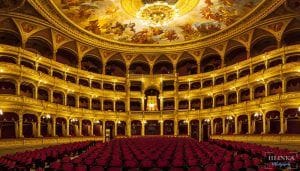- On 13 January, 2025
- In Places to see Tips for travelers
- Tags: Andrássy Avenue, Budapest Opera House, Parliament, Pest District, Shoes on the Danube Bank, Sisi Square, St. Stephen's Basilica, Vörösmarty Tér
Explore the vibrant Pest District, where urban life blends with the most iconic landmarks of Hungary’s capital.
Pest is the dynamic heart of Budapest, brimming with history, culture, and modern urban life. It is home to some of the city’s most iconic sights, making it a must-see area for any visitor. From historical landmarks to architectural gems, Pest offers a variety of attractions that will make your visit unforgettable.
District V, the Heart of Pest
The eastern half of Budapest, Pest, is the center of both daily life and tourism. With its grand avenues, elegant squares, and classic architecture, District V is the perfect place to stroll, enjoy local cuisine, and soak in the essence of the city.
Hungarian Parliament
One of Budapest’s most iconic buildings, the Hungarian Parliament, also known as the Országház, symbolizes the country’s history and sovereignty. Constructed between 1885 and 1904, this architectural masterpiece reflects Hungary’s grandeur through its combination of Neo-Gothic, Neo-Renaissance, and Baroque styles.
Why Visit the Parliament?
Visiting the Parliament offers a unique experience to marvel at its impressive architecture and learn about Hungary’s rich political history. The building boasts 365 Gothic spires and an extensive art collection adorning its corridors. One of the tour highlights is the chance to see the Hungarian crown jewels, including the Holy Crown of St. Stephen, symbolizing the nation’s unity and continuity.
Additionally, the Parliament’s location on the banks of the Danube River provides breathtaking views of the river and the Buda side of the city, making it one of Budapest’s most photogenic spots.
How to Visit the Parliament?
Access to the Parliament is only available via guided tours, as it hosts government offices and official events. Tickets can be purchased online through the official site, where visitors can choose their preferred tour language and time slot. The 45-minute guided tour costs 6,500 HUF (approximately 16 EUR) for EU citizens. Booking in advance is recommended to avoid long queues, especially during peak tourist seasons.
Exploring the Hungarian Parliament is not only an architectural delight but also a deep dive into the country’s political heritage.
Shoes on the Danube Bank Memorial
The Shoes on the Danube Bank (Cipők a Duna-parton) is a moving tribute to the thousands of Hungarian Jews who were executed during World War II by the Arrow Cross Party. Installed in 2005, the memorial consists of 60 pairs of iron shoes placed along the riverbank on the Pest side, near the Parliament.
This powerful installation was conceived by film director Can Togay and sculptor Gyula Pauer to remember the victims who were forced to remove their shoes before being shot and thrown into the Danube. The shoes symbolize men, women, and children, preserving the memory of their individuality and the horrors they faced.
Located along the Danube promenade, this solemn site invites reflection and remembrance, making it an essential stop for anyone visiting Budapest.
St. Stephen’s Basilica
St. Stephen’s Basilica (Szent István-Bazilika) is one of Budapest’s most recognizable landmarks, situated in the heart of Pest. Dedicated to St. Stephen, Hungary’s first king, the basilica was completed in 1905. Its grand neoclassical façade and impressive dome, rising to a height of 96 meters, make it one of the tallest structures in the city.
Inside, the basilica houses the Holy Right Hand of St. Stephen, a highly revered relic. Visitors can attend organ concerts, climb the panoramic terrace for stunning views of Budapest, and explore the basilica’s treasury.
Admission to St. Stephen’s Basilica costs 2,300 HUF (approximately 6 EUR) for adults, with discounts available for students and retirees. Visitors can also access the panoramic terrace for a fee of 4,300 HUF (approximately 12 EUR). Combined tickets, including access to the treasury, are available for 6,000 HUF (approximately 16 EUR). The dome can be reached by elevator or by climbing 364 steps, offering a memorable experience and breathtaking city views. Further information are available here.
St. Stephen’s Basilica is not only a symbol of religious significance but also a testimony to Hungary’s architectural and cultural heritage.
Sisi Square (Erzsébet Tér)
At the heart of Budapest lies Erzsébet tér, or Sisi Square, the city’s central urban hub. The square serves as a major transport connection point, making it a vital area for both locals and tourists. Beyond its practical importance, the square offers several attractions that add to its charm.
One of the most prominent features of Erzsébet tér is the Budapest Eye Ferris wheel, which offers panoramic views of the city. Despite being a popular attraction, we suggest skipping the ride due to the high admission price of around 13 EUR. Instead, explore the surrounding green spaces where locals gather to relax, read, and enjoy the atmosphere.
Andrássy Avenue
Connecting Erzsébet tér to Heroes’ Square, Andrássy Avenue is one of Budapest’s most famous boulevards. Built between 1872 and 1877, it was declared a UNESCO World Heritage Site in 2002 for its historical and architectural significance.
This elegant avenue is lined with neo-Renaissance mansions and palaces and is home to some of the world’s most exclusive boutiques. It is the perfect place to stroll and admire the city’s architecture.
Budapest Opera House
The Budapest Opera House is one of the most iconic and beautiful buildings in the city. Recently restored, it offers an incredible experience for visitors. We highly recommend attending one of the performances held throughout the year, as tickets are usually very affordable. If opera isn’t your thing, guided tours of the interior are also available.
Additional information are available here.
Liszt Ferenc Academy of Music
This prestigious music institution is renowned for its Renaissance architecture and exceptional concert hall. The academy is a hub for talented musicians and a must-see for music enthusiasts.
Saxlehner Palace
A classic-style palace, Saxlehner Palace exudes timeless elegance with its refined architectural details. Built between 1884 and 1886, it was once the residence of aristocracy.
Dreschsler Palace
Dreschler Palace is a beautifully restored Renaissance-style building that once housed the Hungarian Academy of Dance. Its intricate façade and ornate details make it a standout architectural gem.
Vörösmarty Tér
Located in the heart of Budapest, Vörösmarty Square is one of the city’s most prominent commercial and cultural hubs. Home to the oldest historic café in Budapest, the Gerbeaud Ház, the square has been a witness to significant historical events and continues to be a lively gathering place for both locals and tourists.
Founded in 1870, Gerbeaud Ház is a renowned café known for its elegant ambiance and classic décor. Visitors can indulge in traditional Hungarian pastries such as Dobos cake, Krémes, and the signature Gerbeaud cake while soaking in the café’s rich history. The outdoor terrace is especially popular during warmer months, offering a perfect spot to relax and enjoy the vibrant atmosphere of the square.
Vigadó Tér
Situated along the Danube River, Vigadó Square provides stunning views of the Buda side of the city, including iconic landmarks such as the Gellért Hill and the Liberty Statue. Visitors can also spot the famous Little Princess Statue, a charming sculpture that has become one of Budapest’s beloved symbols.
Vörösmarty and Vigadó Squares are central points of interest in Pest, offering a blend of cultural heritage and modern urban life, making them must-visit spots during any trip to Budapest.
If you want to get to know more about Budapest, don’t miss our free walking tour of Pest.

